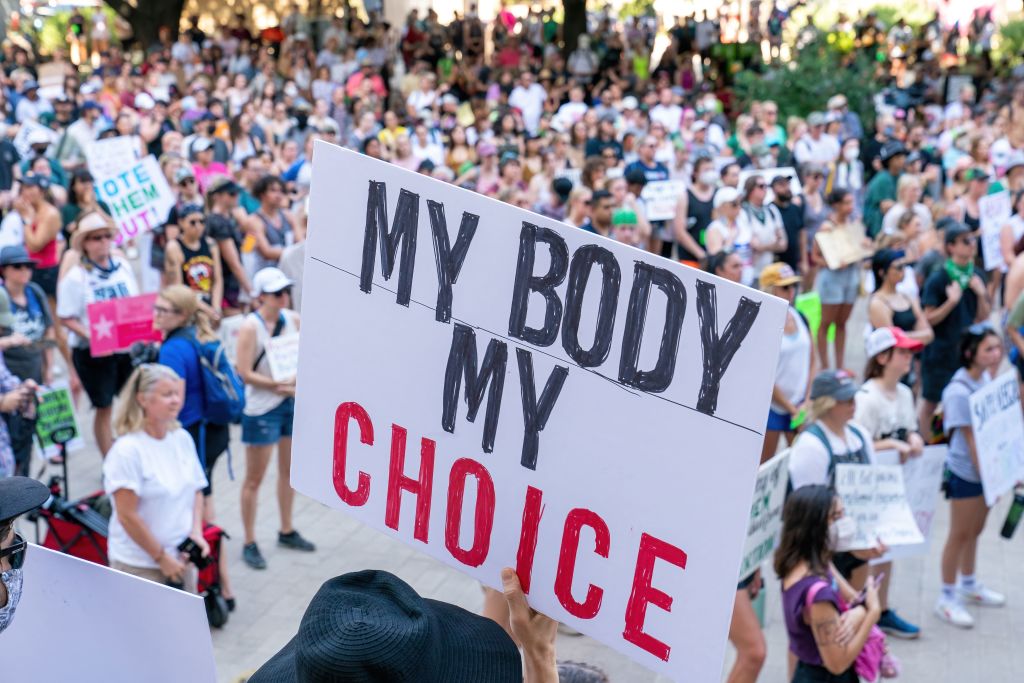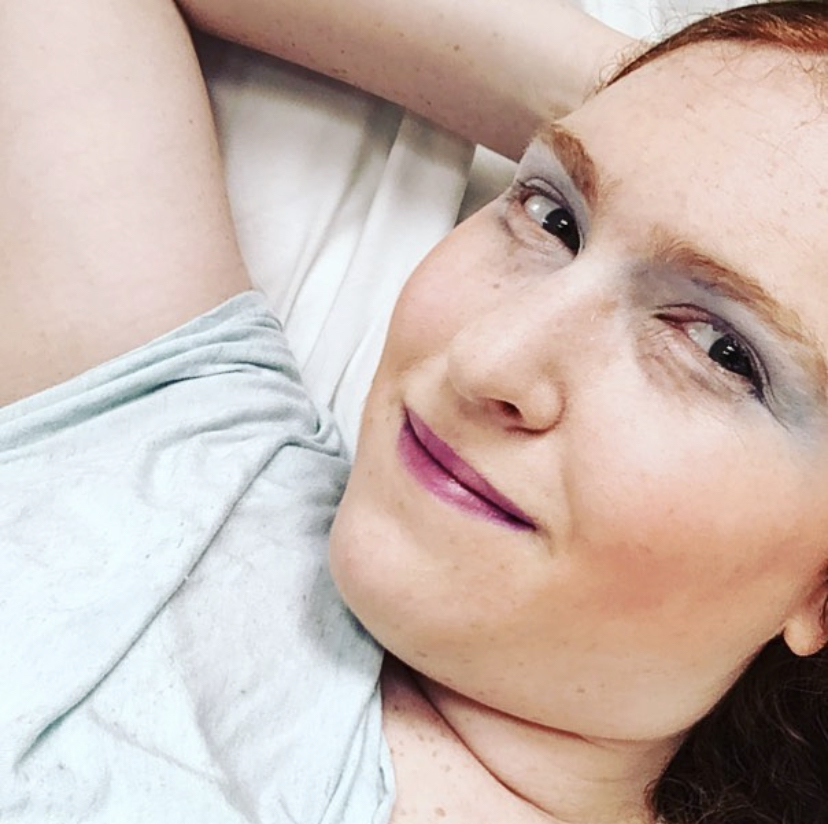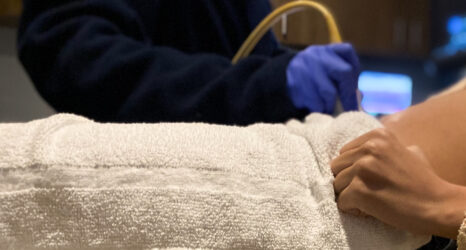Update on Sept. 15: Check out the Seen Stories feature on Red’s story here.
On June 24, the Supreme Court overturned Roe v. Wade, effectively stripping the constitutional right to abortion access after 50 years. The new precedent saw many of our worst fears finally come to fruition, sparking justifiable outrage and immediate protests across the country.
Now that the legality of abortion and reproductive healthcare lies with individual states, disabled and neurodivergent people are among the most vulnerable.
One in 44 children in the U.S. have been diagnosed with autism spectrum disorder (ASD); one in 189 are female. However, this is likely an undercount, as it does not account for many trans or nonbinary autistic people, self-diagnosed autistics or late-diagnosed autistic women (officially diagnosed as autistic during teen years and older).
I am autistic and, at the age of 21, after a year of fighting for it, I successfully underwent tubal ligation surgery. Here’s why I did it—and why the Court’s decision to overturn Roe will ultimately hurt other disabled and neurodivergent women and nonbinary people like me.

Choosing Tubal Ligation
A tubal ligation, sometimes known as tubal sterilization, is a surgical procedure in which the fallopian tubes are either cut, tied, blocked or removed all together as a way to permanently prevent the person from getting pregnant. Usually, in bodies assigned female at birth, one of two ovaries releases at least one egg every month. Then, for the next few days after the release, the egg moves through the fallopian tubes, waiting for sperm to fertilize it. Tubal ligation cuts off the path for sperm to get to the ovaries, thus preventing fertilization. However, it does not cause the usual menstrual cycle to stop.
The specific birth control pills I was (and still currently am) on are only about 75 percent effective at preventing pregnancy, according to my doctor. Their main purpose is regulation of my menstrual cycle and lessening the pain of my period cramps. I started researching other methods of birth control that were more permanent in 2016 and eventually discovered tubal ligation on the Planned Parenthood website. After looking into tubal ligation, as well as other methods of birth control, I decided it was the best option for me.
While I hadn’t previously given sterilization serious consideration, I always knew I never wanted kids. Since I had been on birth control pills since I was 16, was single and was a lesbian, I didn’t think that this kind of procedure was appropriate for me at that time. And prior to 2016, Obama’s presidency and the seeming guarantee of Roe gave me a feeling of security in my reproductive rights—a feeling that suddenly ended on Nov. 8, 2016, with the election of Donald Trump. Over the next several years, seeing his constant attacks on women’s reproductive rights, I started to worry for the future of my own health and decided to take my future into my own hands.
The average age for a woman to get a tubal ligation is 33 years old. At the time, I was only 20. When I told my parents, my mom told me it was “the most mature decision I have ever made.” My dad, on the other hand, was on edge about his 20-year-old daughter getting this kind of procedure done. Ultimately, though, he got on board and still supports my decision to this day.
Unfortunately, doctors with whom I talked about performing the procedure raised other concerns. Since I was only 20 years old and autistic, there was concern that I didn’t know what I was doing and that, in 20 years, I could possibly regret it and sue the hospital—their words, not mine. Many also believed that since I was single, openly gay and not sexually active, there was no real rush or point to get the surgery done at that time.
While I understood their concerns, I knew fully in my heart and soul that this was the best option for me. I even presented to them letters from my therapist and psychiatrist, saying that I know what I am doing and that I should be able to get the surgery. It still took a year to find one who listened to us and was willing to perform the procedure. (The previous doctors who rejected me, despite the multiple letters, were men. The one who listened and ultimately agreed to do it was a woman.)
The History of Forced Sterilization in the U.S.
Though undergoing this procedure was my choice, I can’t ignore the historical precedent of forced sterilization of disabled women. This violent history of control was most recently highlighted with the case of Britney Spears, who was forced to have an IUD while under conservatorship.
Men have an extensive history of inappropriate involvement in women’s reproduction. Early in the 20th century, when the eugenics movement was gaining traction, many states established legislation allowing for the forced sterilization of disabled people. In a broad and discriminatory ruling written by Justice Oliver Wendell Holmes, the Supreme Court affirmed forced sterilization statutes in an 8–1 vote in 1927.
Carrie Buck, the complainant in that case, Buck v. Bell, contested the necessity of her forcible sterilization. She had been brought in as a servant by a family, whose relative had sexually assaulted her, and they had labeled her as “feeble-minded.” The family had her committed to an institution where they intended to sterilize her in order to conceal the subsequent pregnancy. Justice Holmes wrote the majority opinion for the court:
“It is better for the world, if instead of waiting to execute degenerate offspring for crime, or to let them starve for their imbecility, society can prevent those who are manifestly unfit from continuing their kind.”
In the wake of that decision, over 70,000 people, most of them impoverished people of color, were forcibly sterilized between 1907 and 1945 as a result of the federal government’s pro-eugenic sterilization regulations. To this day, the Buck v. Bell decision has never been overturned, giving the courts and abusive conservators ultimate power over disabled women’s reproductive health.
A Decision Regarding the Physical and Emotional Security of My Reproductive Health
There are a number of reasons why women undergo tubal ligation, but according to the University of Iowa Health Care, the procedure is mainly performed on women who are “absolutely certain she does not want to have children in the future.”

While I can’t speak to every individual reason and experience, here are six reasons why I personally chose to undergo a tubal ligation:
1. I do not ever want to be pregnant.
First and foremost, let’s make this clear: I never want kids. But, even if I were to somehow change my mind in the future, I still know I never want to get pregnant or have to go through the process of carrying a child and giving birth to it.
2. Regardless of my sexual orientation, there was still a chance of becoming pregnant.
Even though I was not sexually active, I knew that there was still a chance I could get pregnant. In 2018 study, an estimated 2.9 million women in the U.S. experience a rape-related pregnancy during their lifetime. And given that 46 percent of lesbian women (compared to 43 percent of heterosexual women) report being victims of sexual violence, I knew, despite my sexual orientation, I could be a victim no matter what I did.
4. Lowering my risk of cancer
A huge factor in my decision to undergo the procedure was reducing the chance of developing ovarian cancer in the future. My mom is a survivor of ovarian cancer and my family has a history of both breast and ovarian cancer; this risk played a large part in my decision to choose my tubal ligation. The procedure is associated with a nearly 30 percent reduction in the risk of invasive ovarian cancer, per one study.
UPDATE: On Thursday, Aug. 18th, 2022, after nine years of fighting, my mom officially died of Ovarian Cancer.
5. Autism
At the time I decided to undergo the procedure and for many years after, one of the main reasons I didn’t want to have biological children was because I am autistic and didn’t want an autistic child. Multiple studies, supported by many autistic advocates like myself, support the belief that autism is genetic.
There aren’t any studies (at least from what I was able to find) on the likelihood of a child being autistic if at least one of the biological parents is also autistic. (I would’ve thought there’d been more information on this, as autistic people are barred from donating eggs and sperm, respectively.)
6. My body, my choice
Regardless of my personal reasons or how other people feel about it, one thing is for certain: This was a decision I made regarding the physical and emotional security of my reproductive health.
One Thing I Did Not Feel: Regret
After a year of fighting and searching, we finally found an ob-gyn at UCLA Hospital who was willing to perform the surgery on me. And finally, at 7 a.m. on Aug. 7, 2017, I was wheeled in for surgery. To make me more comfortable, since I had never had surgery before, the nurses talked to me about my interests, school and music. I told them how much I loved Taylor Swift and her song “Shake it Off.” When we reached the operating room, they put that exact song on—making me smile. The last thing I remember hearing is Swift singing Black Space: “Darling, I’m a nightmare dressed like a daydream.”
Upon waking from surgery, I found myself in another room. My throat was sore, my lower abdomen was in pain and I felt out of it. A lot of people would like to believe I either felt joy and happiness or despair and regret after the surgery. That was simply not the case. I was still high from the anesthesia—I just felt a bit numb. One thing I did not feel was regret.
The weeks following the surgery were a time to process what had happened—the fact that, from then on, I was permanently infertile at age 21. I spent a lot of time reading, watching YouTube videos, watching television and sleeping.

Pro-Choice Also Includes Disabled Women
Today, I am 26 years old. It has been five years since my surgery. To this day, I do not regret getting my fallopian tubes removed.
I can’t tell what the future will be, but I can say this: It’s probably the most cathartic thing I have ever done for myself and I couldn’t be more happy to have done it.
Being pro-choice doesn’t just mean supporting the right to abortion for cisgender, able-bodied, neurotypical women. Pro-choice also includes disabled women and our choice of reproductive healthcare. The overturn of Roe v. Wade has taken that away—and it’s only likely to get worse.
U.S. democracy is at a dangerous inflection point—from the demise of abortion rights, to a lack of pay equity and parental leave, to skyrocketing maternal mortality, and attacks on trans health. Left unchecked, these crises will lead to wider gaps in political participation and representation. For 50 years, Ms. has been forging feminist journalism—reporting, rebelling and truth-telling from the front-lines, championing the Equal Rights Amendment, and centering the stories of those most impacted. With all that’s at stake for equality, we are redoubling our commitment for the next 50 years. In turn, we need your help, Support Ms. today with a donation—any amount that is meaningful to you. For as little as $5 each month, you’ll receive the print magazine along with our e-newsletters, action alerts, and invitations to Ms. Studios events and podcasts. We are grateful for your loyalty and ferocity.
Up next:





